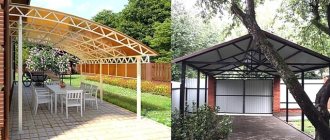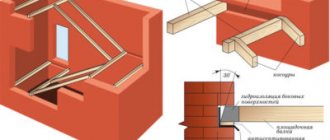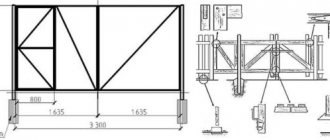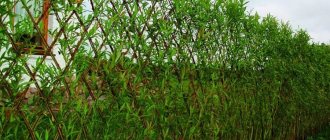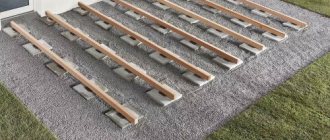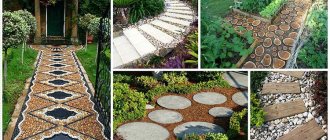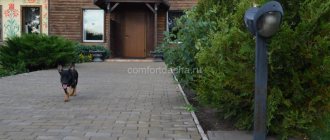Paths on the site both help comfortable movement and decorate the territory. But all the beauty can be ruined by heavy rains or melted snow if you do not secure the garden path along the edges with a border that will prevent the soil from spreading.
Paths with a soft surface (gravel, bark, wood chips or grass) especially need to be limited, and the paving stones will take on a finished look thanks to the curb stones. Various materials can be used to frame the paths. We have selected the most popular options.
Concrete curbs for paths
Concrete borders are universal: they can be used to enclose not only garden paths, but also beds and tree trunks. From fresh mortar you can build a frame of any shape and size.
There are a huge variety of design solutions for decorating the edge of a walkway with a concrete curb. There are even special devices that allow you to independently make the top of the border curly, for example, semicircular.
If you have never worked with concrete or are not confident in your abilities, then you can use the help of specialists.
A border made from pieces of concrete is suitable for framing grass paths
However, you can use not only fresh solution, but also frozen pieces of this material, laying them around the perimeter on geotextiles, which will not give a chance to weeds and prevent soil subsidence. Hostas planted along the path will look especially good against the background of such a border.
Types of plastic borders
Plastic fences are considered a universal solution for any suburban area. The territory will always look well-groomed, regardless of which border is chosen - decorative or functional, inconspicuous. The products offered by the manufacturer can be divided into the following types:
- Sectional fencing . They consist of a set of identical parts with fasteners. Installing a fence is reminiscent of playing with a children's construction set - quickly and easily; the result is a neat path or an elegant flower bed.
Fragment of a sectional fence as a separator Source market-sad.ru
- Tape fencing . They look like flexible tape and are sold in rolls. Such borders well fix the edges of a path of any shape, preventing lawn grass from growing, but they are almost completely in the ground and therefore cannot play the role of decorating the landscape. On the other hand, this is their positive quality: ribbon borders are suitable for decorating paths made of any material.
- Ready-made fencing . Such borders imitate a fragment of a fence made of natural material and look like a board, curb stone or tile.
Brick border for garden path
If you have a lot of brick left on the site after construction, then it will be useful both for creating a hard surface for the garden path and for installing a border to it. This material is most popular in Russia.
The bricks can be laid at the same level with the surface of the path at the end of it, filling the seams with soil or connecting with concrete mortar (this way the curb parts will hold more securely). This edging will make the path neater and will not interfere with the work of the lawn mower when cutting the grass along it.
You can also lay the bricks on a corner, sprinkled with a little sand, then they will protrude above the surface and protect the path from overhanging vegetation. But to mow the lawn along such a border you will have to use a trimmer or scissors.
To prevent the brick curb, which resembles saw teeth, from crumbling, you can also use cement to form its base.
Construction of a mini-brick wall
You can even build a small mini-wall from bricks along the edge of the path, which will zone the space. Usually it is built next to ornamental plants hanging over the path.
- What can be made from unnecessary bricks at the dacha: 10 useful ideas
You are left with a large mountain of bricks from the construction of your dacha. We tell you where to “place” it, literally and figuratively.
Fencing for flower beds: species diversity
When designing flower beds and garden paths, it is important to include borders in your site plan. The design element performs the following functions:
- emphasizes the unity of style in the area near the house;
- limits the boundaries of plantings of flowers and shrubs, does not allow seedlings to grow beyond the limits of the limiter;
- prevents the penetration of plant root systems beyond the boundaries of the garden bed or flower bed;
- visually delimits space, creates a comfortable atmosphere;
- protects plantings from trampling and destruction during heavy rains.
When selecting an element, the type of configuration and height of the fence are determined.
Choosing a border type
The type of border is selected in accordance with the objectives of the element. To form a high embankment for a flower bed, a strong fence of stone blocks and bricks is required to keep the soil from crumbling and being washed away by intense watering and heavy rains.
To limit perennial shrubs from growing into the surrounding area, borders with a large depression are needed. It is optimal to use stone blocks, brick on a concrete base or a monolithic metal fence. An iron fence can be used to limit a front garden with branchy bushes (raspberries, gooseberries). The fence can be purchased in a store or made with your own hands from improvised materials.
When installing a border on a flat area, the element helps to zone the area; low structures with low mass (plastic, branches) are suitable for demarcation. To block the growth of the root system, materials made from synthetic components are used.
Fence height
Depending on the tasks, the height of the fence differs. To decorate a site, it is optimal to use a plastic fence 7 cm high. To decorate flower beds along garden paths, a fence height of about 10-15 cm is required. To create a border for planting trees, shrubs, and three-dimensional plants, a fence 0.5 m high is required. For flower beds of complex design (mixborders), including several tiers and rows, small flat stone blocks, paving slabs are enough to visually delimit the space.
If there are several lawns and flower beds in the garden plot, you can use 3-4 types of fencing in the same color scheme, differing in height. High borders are used for front gardens, low ones for flower beds. The fence should not reduce the view of the space decorated with plants.
Wooden borders for paths
Wood, of course, is not as durable a material as cement or brick, but it looks great as a path border and is much cheaper, if not completely free. Particularly original are fences made of wooden chocks. They can be prepared in the fall after pruning the trees. Chocks are installed both on one side of the path and on both.
Wooden sleepers, which were previously used to make steps for stairs, can also be used as a border. Sleepers can be placed vertically or horizontally in the ground. When installed vertically, bars of different heights will look interesting.
Board border for walkway with wooden decking
The simplest border is made of wooden boards, which can simply be dug along the path, or bars can be installed longitudinally. If the path covering is also wooden, then the boards should be nailed down to make it more durable.
From a decorative point of view, wooden borders have other advantages. The boards can be painted in any color and height adjusted, given any shape and combined with a variety of garden accessories.
In order for wooden borders to last as long as possible, they must be regularly treated with antiseptic agents. However, even with the best care, they “will not live” longer than 10-12 years.
- What you can make from wooden cuts with your own hands: a selection of original ideas
Do you have an old tree or Christmas tree on your property that you just can’t find a use for? And we have already found it!
Fence height
Sometimes borders for flower beds are also borders for paths. If just such a tandem is installed, then the height of the fence increases to 12-15 cm.
If you are creating only a border for a flower bed, and it is an enclosing and decorative element, then a height of 5-7 cm is sufficient.
If the plants in a flower garden need to be protected from pets or from the curiosity of small children, then a structure up to 40 cm high is built.
Flower beds raised above the surrounding space will look great along paths and at the boundaries of zones. They are often installed when there is a pronounced relief on the site. When constructing a raised flower bed, its edge will be a small retaining wall.
The height for the protective, decorative and enclosing functions of the border has been sorted out.
Let's consider how flower garden plants influence the height of the fence. This is a very important point when creating landscape design on the site. If the flowerbed is decorated with low flowers and ornamental plants, up to 30-40 cm, then a border of the same height will partially cover all the blooming beauty. And, conversely, a 6 cm border looks ridiculous against the backdrop of tall phlox or rose bushes. Therefore, the height of the fence should take into account the height of the growing plants in the flower bed.
Metal border for the path
Ideal for paths with a soft surface (gravel, wood mulch), metal borders are suitable, which prevent the scattering of small components of the loose layer over the area. In addition, this fence, driven to a certain depth into the ground, prevents plant roots from growing in the soil.
A metal border is a strip of steel, aluminum or copper. It is much easier to install than concrete. And although such a fence looks rather modest, it fulfills its function of dividing territories impeccably. And for decorating areas with strict geometry, a metal border is excellent, which is why it is widely used by landscape designers.
However, metal borders can be replaced with cheaper plastic ones, which are durable and easy to install. They can be installed along the perimeter of paths with any surface.
Decorative borders-ribbons
Border strips are made of plastic. They are produced in rolls for ease of installation. Most often they are used to design narrow paths near flower beds that have a complex shape. Manufacturers of garden tools also produce sectional strip fencing. Installation is the simplest: the structure is stuck into the ground.
Tape installation:
- The tape is left unrolled in the sun for 2-3 hours before installation. This will allow the material to be given the desired shape during installation.
- While the tape is heating up, a narrow and shallow groove is dug.
- The resulting groove is compacted well.
- Next, the border tape is unrolled around the perimeter of the flower bed or along the garden path. The tape takes the form that was planned in advance.
- The outside border is decorated with pebbles, glass balls, peat, and colored mulch. Decorating gives the fence an impressive look and strengthens the flower bed.
Plastic border tape for creating flower beds has the following advantages:
- tapes are used to create fences of the most exclusive shapes;
- the material is not subject to external influences;
- the tape is resistant to drugs used when spraying green spaces;
- the shape and shade of the border will remain for 3-5 years;
- the weight of the structure is small, while the strength of the tape is high;
- installation of the tape is easy and simple, no special skills or preliminary preparation are required;
- the cost of border tape is low, and this increases its popularity among summer residents;
- Maintenance costs and efforts are kept to a minimum.
Border strips have important functions:
- protection of the flower garden from pollution;
- support of the flower bed line;
- fixing the base of the garden path, preventing it from spreading;
- the tape does not allow plants to grow beyond the flowerbed area;
- protecting the soil of the flower bed from erosion.
We recommend studying: low-growing ornamental trees for the garden, which will become its main decoration
Stone path border
The best frame for a path made of pebbles or gravel can rightfully be considered a border made of natural stones, which do not even have to be selected by size and color. Boulders can simply be dug into the ground, and small stones can be secured with cement.
Just like with brick, you can even build a low stone wall that will add some atmosphere to your area. However, natural stone (marble, sandstone, pebbles, limestone or granite), if not collected independently from nature, is quite expensive, but it can be replaced with a more budget-friendly option - artificial stone.
Imitation stone borders look neat and are easy to care for.
Soft fencing for garden paths made of crushed stone
You can protect the garden path from the lawn or lawn using crushed stone or pebbles. Dig a shallow ditch along the path, lay geotextiles at the bottom, and then pour the selected material. Such a “soft” border will reliably protect the path from vegetation and emphasize its advantages.
- 35 photo ideas on how to use stones and boulders in landscape design
Simple compositions and complex, spectacular solutions made from stones and boulders - add individuality to your site!
Models of plastic borders
Plastic products are made from high-strength recycled polyethylene. A variety of sizes and a wide palette of colors allow you to choose a fence that matches any style of site. The most popular types of garden borders include the following products:
Border "Country"
Refers to tape materials, made of elastic plastic, resistant to solar ultraviolet radiation and low temperatures. It looks like a tape with a thickening in the form of a tube in the upper part. The lower part is equipped with a small bend for fixation in the ground. The standard length of this roll limiter is 10 m, width - 10-11 cm, thickness (in the middle part) varies from 1.6 to 2 cm. Products are available for sale in black and white, brown, terracotta and green.
Border "Country" in the design of a flower bed Source vg45.ru
"Labyrinth"
The material looks like small blocks of natural stone. Adjacent blocks are fastened together using grooves and protrusions and are additionally fixed in the ground with fastening stakes. The blocks are not exposed to frost, precipitation and sunlight. Since the curbs for “Labyrinth” paths are installed on the ground surface, they can be easily moved to another location if necessary. This type of fencing looks impressive when framed by flower beds, lawns and paved paths.
See also: Catalog of companies that specialize in landscaping work on sites.
Set "Old Stone"
It is a set of elements of different sizes, the combination of which allows you to originally separate the path from the flower bed. The blocks have a size of 15x30 or 30x30 cm; they are laid on the surface of the soil or slightly buried. “Old stone” is suitable for constructing straight sections of paths or for multi-tiered structures (for example, for a low retaining wall, you can build masonry several blocks wide and high); the parts are secured with plastic nails. On rounded areas, such a border looks angular.
Storm drain gratings instead of curbs
To protect paths from the effects of excessive precipitation and to remove moisture, soil drainage is often used. To do this, grooves are dug on the sides of the path, geotextiles are laid on the bottom, covered with coarse sand, gravel or crushed stone, and covered on top with water intake grates for storm drainage.
The covering of garden paths in areas with excess moisture should be done with a slight slope: slightly raised in the center and lowered at the edges. This way, the water will not linger on the path, but will flow into the drainage grooves.
There are other ways to arrange paths in the garden.
- 10 questions about arranging a path in the garden
We have collected the most frequently asked questions about creating garden paths on a site and answer them in the article.
Video description
About installing the Geoplastboard plastic border in the following video:
- Convenient transportation . A roll of material 150 m long can be easily transported in the trunk of a car.
- Easy installation . There is no need to carry out excavation work - dig trenches and concrete the base; the soil is only pre-leveled and compacted.
- Physical characteristics . Made of polypropylene, bends to any required radius.
- Care . Does not require additional care.
Positive qualities also include the Geoplastboard’s ability to withstand significant temperature changes and a ten-year warranty from the official manufacturer.
Advantages and disadvantages of plastic fencing
Plastic borders have many advantages:
- Low price. If we compare the cost of plastboards with traditional materials for finishing flower beds and paths (concrete, stone, brick), then the cost of the former will be much lower. This will allow any owner to buy them.
- Large selection of models. This will help you choose the most suitable option for your dacha or private home area.
- Versatility. There are borders that can be used to border various garden objects.
- Multifunctionality. Some types of fencing also serve to protect paths from unfavorable natural factors and decorate the dacha area.
- Rich colors and shapes. Due to the fact that plastboards are available in several colors and have a corrugated, smooth, patterned surface, they can be used in areas of different styles.
- Easy delivery and installation. The light weight and size of the fences, collapsible sections allow you to bring them to the dacha or home in your own car. To install curbs, you do not need to dig deep ditches, add a sand bed or create drainage.
- Save time. Installation of border elements does not require much time.
- Easy care. After installing the plastic structure, it will be easy to care for. To clean it from dust or soil, you will need to water the plastboard with a stream of water from a hose.
- Long service life. For the manufacture of fencing materials, wear-resistant plastic is used, and the sectional elements are equipped with strong and reliable fasteners.
- Resistance to adverse natural phenomena. Plastic borders do not fade in the sun, do not crack from frost, and are not afraid of humidity. They tolerate temperature fluctuations well and do not deform when the soil swells and moves.
- Reusable. If the owners want to transform their site and redesign the flower beds or some paths, they can dismantle the fences that were once installed and, moving them to another place, reassemble them.
Features of application
A plastic border can separate one garden area from another, for example, a lawn from an area with a gazebo or a swimming pool from a garden area. The material reliably strengthens the edges of the paths and protects them from crumbling and destruction. At different times of the year, during heavy rains or melting snow, it prevents sandy paths from washing away, maintaining their integrity.
Thanks to its flexibility, plastic gives the flower bed any beautiful shape. With its help, you can easily create a multi-tiered structure for plants that will fit well into the design of the site.
A variety of shapes of edging material will give the area an original look, and a rich color palette will help you choose a shade similar to the tiles of the path or the walls of the house.
To deliver a plastic board, as this fencing is also called, to the site, you do not need to hire a truck. And you don’t need to spend a lot of time and effort to install the material.

